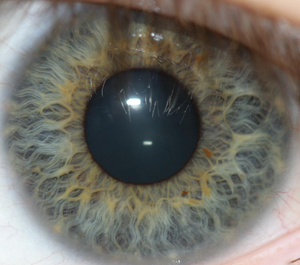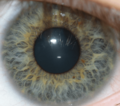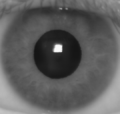Iris recognition facts for kids
Iris recognition is a cool way to identify people using a special camera. It looks at the colorful part of your eye, called the iris. Each person's iris has super detailed patterns that are totally unique, like fingerprints! These patterns stay the same your whole life and can even be seen from a little distance.
This technology is really good at telling people apart, even in huge groups. It helps avoid mistakes where someone might be wrongly identified. One challenge is taking a clear picture if someone is far away or not looking directly at the camera. But new technology is making it possible to scan irises from farther away, even up to 10 meters!
Some people confuse iris recognition with retina scanning. Retina scanning looks at the blood vessels at the back of your eye, which is different. Iris recognition uses a video camera with a soft, invisible light (called near infrared light) to capture the amazing details of your iris. Computers then turn these patterns into a special code. This code helps identify you or spot someone trying to pretend to be you. These systems can check millions of codes every second with very few errors.
More than 1.5 billion people worldwide use iris recognition systems. This includes many people in India for their national ID program called Aadhaar. It's used for things like national IDs, government services, getting benefits, security, and even crossing borders without a passport. A big plus of iris recognition is how fast it works and how rarely it makes mistakes. Plus, your iris is protected inside your eye, so its patterns stay stable over time.
In 2023, Pakistan started using iris recognition for its national ID cards. Soon, it will also be used by banks and law enforcement.
Contents
How Does Iris Recognition Work?
First, the system finds the edges of your iris (the pupil in the middle and the outer edge) in the eye image. Then, it removes parts that might hide the iris, like eyelids, eyelashes, or bright reflections. The clear iris part is then stretched a bit by the computer to make up for your pupil getting bigger or smaller.
Next, a special computer program analyzes the iris pattern. It turns the unique details of your iris into a digital code, like a secret key. This code is mostly about the "phase" of the patterns, which means it's not affected by how bright the light is. This helps the system work well over many years.
When you need to be identified, the system takes a new picture of your iris and creates a new code. It then compares this new code to the codes stored in a database. If the codes are very similar (meaning only a few bits are different), the system knows it's you! It's super unlikely for two different people to have such similar iris codes because everyone's iris is so unique.
Why Is Iris Recognition So Good?
The iris is often called the perfect body part for identification for many reasons:
- Protected and Stable: Your iris is inside your eye, protected by a clear layer called the cornea. This keeps it safe from damage and wear, unlike fingerprints which can change from hard work.
- Unique Patterns: The fine patterns in your iris are formed randomly when you're a baby. Even identical twins have different iris patterns, and your left and right eyes have different patterns too!
- Easy to Scan: An iris scan is like taking a photo. It can be done from a few inches to several feet away. You don't have to touch any equipment, which is great for hygiene and for people who might not like touching shared surfaces.
- Very Accurate: The main iris recognition method, called IrisCode, is incredibly accurate. It has a super low chance of making a mistake and identifying the wrong person.
- Works with Glasses: It works even if you wear clear contact lenses, eyeglasses, or non-mirrored sunglasses.
- Long-Lasting: The detailed texture of your iris stays the same for many decades. Some people have been identified successfully using scans taken 30 years apart!
What Are the Challenges?
Like any technology, iris recognition has some challenges:
- Can Be Tricked: Some older or simpler iris scanners can be fooled by a high-quality picture of an eye instead of a real one. However, newer systems are much better at detecting this.
- Needs Cooperation: It can be hard to scan an iris if the person isn't holding still or looking directly at the camera. But new systems are being developed that can identify people from a distance or even while they are walking.
- Cost: Iris scanners can be more expensive than other security systems like passwords or card readers.
- Image Quality: If the picture taken is blurry or poor quality, the system might not be able to enroll you or identify you correctly.
- Privacy Concerns: Some people worry that governments could use this technology to track individuals without their permission.
- Medical Changes: Sometimes, eye surgeries like cataract surgery can change the iris texture, making it harder for the system to recognize it.
Keeping Iris Scanners Safe
To make sure iris recognition is secure, it's important to check if the eye being scanned is a real, live eye and not just a picture or a fake. This is called "live-tissue verification."
Here are some ways systems try to do this:
- Pupil Reflex: Changing the light during a scan to see if the pupil reacts naturally (gets bigger or smaller).
- Eye Movement: Checking for tiny, natural eye movements or tracking how the eye moves when reading text.
- Reflections: Looking for specific reflections from the eye's surfaces, like the red-eye effect you sometimes see in photos.
- 3D Imaging: Using special cameras to see the iris in 3D, checking its shape and position.
While these methods help, they can sometimes cause a real user to be rejected by mistake. In supervised places, like border control, a person watching the process can also help ensure the scan is legitimate.
Where Is Iris Recognition Used?
Iris recognition is used in many places around the world:
- Border Control: In the United Arab Emirates, all people entering the country who need a visa are scanned. This system has caught over 330,000 people trying to re-enter with fake documents or different names.
- Banking: In 1999, Bank United in Texas was the first bank to use iris recognition at ATMs. In Jordan, Cairo Amman Bank lets customers withdraw cash from ATMs just by scanning their eye, without a card or PIN!
- Refugee Aid: The United Nations High Commissioner for Refugees (UNHCR) uses iris scanning to help distribute aid to refugees in places like Jordan, Pakistan, Malawi, and Thailand. This ensures the right people get the help they need and prevents fraud.
- National ID Programs: India's Aadhaar program has enrolled the iris patterns of over a billion citizens. This helps people get government benefits and services.
- Airports: At Amsterdam Airport Schiphol in the Netherlands, frequent travelers can use iris recognition to pass through border security faster. Similar systems are used at some Canadian airports.
- Police: Some police forces use mobile iris scanners to identify people.
- Security: Google uses iris scanners to control access to its super-secure data centers.
- Smartphones: In 2015, Fujitsu released the first smartphone with an iris scanner. Later, Microsoft Lumia phones and the Samsung Galaxy Note 7 also included this feature for unlocking the phone and other security.
- Mixed Reality Headsets: In 2023, Apple introduced the Vision Pro headset, which uses "Optic ID" (iris recognition) to unlock the device and keep your information safe. It can even tell identical twins apart!
Iris Recognition in Movies and TV
You might have seen iris recognition in your favorite movies and TV shows!
- I Origins (2014): This movie uses iris recognition as a key part of its story, exploring ideas about science and identity.
- Minority Report (2002): In this science fiction film, people use eye scans everywhere. The main character even gets an eye transplant to change his identity!
- The Island (2005): A character uses his eye to get through a security door.
- The Simpsons Movie (2007): This movie has a funny scene showing how tricky it can be to get a good iris scan.
- NCIS: The show features iris scanners for security in their garage and at the entrance to MTAC.
- Red (2010): Bruce Willis's character uses a special contact lens to trick an iris scanner and get into CIA headquarters.
- Angels and Demons: This film and book show an iris scanner being used to break into a high-security facility.
- Demolition Man: This movie also has a scene where a fake eyeball is used to get into a weapons storage area.
Images for kids





